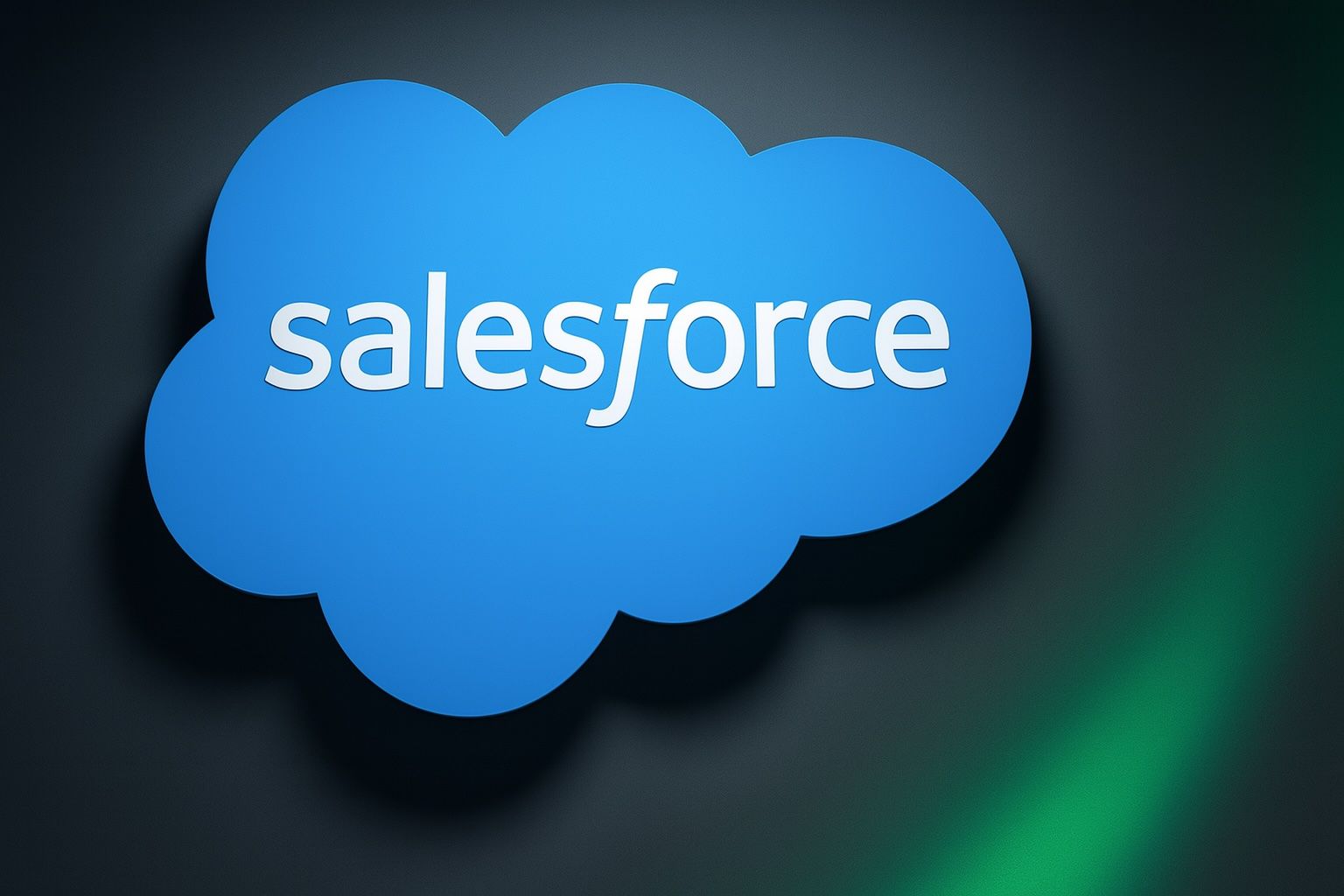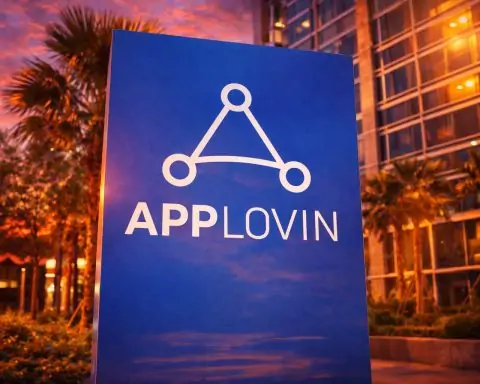Summary of Key Facts (as of October 6, 2025)
- Stock Price: ~$241 per share (intraday Oct 6, 2025), rebounding slightly from recent lows around $235 [1]. The stock is down roughly 27–29% year-to-date and about 14% over the past 12 months [2].
- Market Capitalization: Approximately $230 billion, keeping Salesforce among the world’s largest enterprise software companies [3].
- Valuation:Trailing P/E ~34 and Forward P/E ~19–20, indicating investors expect earnings to accelerate as recent cost cuts and AI investments pay off [4]. Other metrics include a price-to-sales ratio near 5.7 and price-to-book around 3.7 [5]. Salesforce’s beta ~1.22 signals the stock is a bit more volatile than the market [6].
- Recent Performance: Shares have stabilized in the mid-$230s after sliding ~7% in September following soft guidance [7]. The 52-week high was in the upper $200s, well below all-time highs (~$370) from the 2021 cloud boom, suggesting substantial upside if growth reaccelerates [8].
- Market Position: Salesforce remains the #1 CRM platform globally with roughly 24% market share – larger than the next four competitors combined [9]. It generated $10.2 billion in revenue last quarter (+10% YoY) and is on track for ~$41B revenue in FY2025 (FY26 by Salesforce’s calendar) [10] [11].
Recent Stock Performance and Trading Trends
Salesforce’s stock (NYSE: CRM) has been on a bumpy ride in recent weeks. After an early September sell-off, CRM shares closed at $235.69 on Oct 1, 2025, hitting multi-month lows [12]. This dip came as investors reacted to cautious revenue guidance (more on that below). Over the past week, however, the stock showed signs of stability, oscillating in the mid-$230s [13]. By mid-day Oct 6, shares traded around $241, modestly higher than last week’s close. Year-to-date performance stands at roughly -27%, a stark contrast to the broader market, reflecting both company-specific headwinds and sector-wide pressures [14].
In the short term, traders appear to be weighing encouraging long-run potential against near-term uncertainties. The stock’s beta above 1 means it tends to swing more than the S&P 500 – so on market up days, CRM often outperforms, whereas it falls harder on down days [15]. Notably, despite 2025’s slide, Salesforce’s valuation looks relatively cheap compared to peers: about 20× forward earnings vs. 31–32× for Microsoft and Oracle [16]. This discount hints that investors have low expectations baked in, but also that any good news (such as faster AI-driven growth) could spark outsized gains.
Latest Company News (Early October 2025)
In the first days of October, several breaking news items have given Salesforce investors both new reasons for concern and optimism:
- Cybersecurity Scare: On October 3, Reuters reported claims by a hacker group that it stole nearly 1 billion records from Salesforce databases [17]. The cyber gang, calling itself “Scattered LAPSUS$ Hunters,” alleged it obtained troves of customer data by targeting companies that use Salesforce’s platform, though Salesforce stated its own systems were not compromised [18]. The hackers employed “vishing” (voice phishing) to trick client company IT desks and even launched a dark web leak site listing dozens of victim companies [19]. Salesforce has until October 10 to respond to the ransom demand, according to reports, but so far the company insists there’s “no indication” of a breach in Salesforce’s security itself [20]. This incident is a stark reminder of security risks, though it appears the breach was via customer endpoints rather than Salesforce’s cloud. Investors are watching for any fallout or damage to Salesforce’s reputation in trust and data protection.
- Insider Stock Sales: A Yahoo Finance piece by Simply Wall St noted that Salesforce insiders sold about $9 million worth of stock recently, possibly signaling management’s cautious outlook [21]. Such insider selling, while not enormous for a $230B company, raised eyebrows. It could suggest executives felt the stock’s rally earlier in the year fully valued the near-term prospects, or it could simply be routine profit-taking. In either case, the timing (just after earnings and ahead of a pivotal product cycle) has contributed to a slight air of investor caution.
- New AI Partnership: On a more positive note, consulting firm Perficient announced a strategic partnership with Salesforce to advance AI-powered enterprise transformation [22]. Revealed in early October, this collaboration will focus on helping businesses modernize customer and employee experiences using Salesforce’s Agentforce AI and Data Cloud platforms [23]. The partnership underscores Salesforce’s expanding AI ecosystem: Perficient and Salesforce plan joint initiatives to embed Salesforce’s generative AI assistants into enterprise workflows. While not a huge revenue driver by itself, this alliance emphasizes that Salesforce is doubling down on agent-based AI solutions and enlisting a broad partner network to drive adoption. It also coincides with Salesforce’s rollout of Agentforce version 3, which introduced advanced observability and industry-specific features to its AI agent platform [24]. This steady drumbeat of partnerships and product enhancements keeps Salesforce in the news as a leader in enterprise AI.
- Product Rollouts & Events: Salesforce’s flagship conference Dreamforce 2025 (held in September) spotlighted the company’s AI-first roadmap. One highlight was the wider release of Einstein GPT and Agentforce upgrades, which bring generative AI features into Sales Cloud, Service Cloud, Marketing Cloud, and more. Salesforce touts Einstein GPT as “the world’s first generative AI for CRM,” capable of auto-generating content and code across the Customer 360 platform [25] [26]. Moreover, Salesforce will host an Investor Day on October 15, 2025 [27], where executives are expected to detail long-term strategy – investors will be looking for updates on AI monetization, integration of recent acquisitions, and possibly new financial targets.
Financial Results & Business Developments
Salesforce’s recent financial results paint a picture of solid core performance but tempered outlook:
- Strong Q2 FY2026 Results: In its fiscal Q2 (quarter ending July 2025, reported Sept. 3), Salesforce posted $10.2 billion in revenue (+10% YoY), comfortably beating estimates [28]. Subscription and support revenue grew 11%, reaching $9.7B [29]. Profitability also impressed: GAAP operating margin hit 22.8%, with non-GAAP operating margin at 34.3%, marking the tenth consecutive quarter of margin expansion [30] [31]. CEO Marc Benioff hailed it as an “outstanding quarter,” noting Salesforce is on track for a record ~$15 billion in operating cash flow this year [32]. The company returned $2.6B to shareholders via dividends and buybacks in the first half, and the board authorized a massive $20B boost to the share repurchase program to capitalize on the low share price [33].
- Soft Guidance Sparked Volatility: Despite the strong results, Salesforce issued cautious guidance that rattled the market. For Q3 FY2026 (Aug–Oct 2025), it forecast revenue of $10.24–$10.29B (≈8–9% YoY growth) – barely in line and even slightly below Wall Street’s consensus [34] [35]. The midpoint ($10.265B) was just shy of analysts’ $10.29B estimate [36]. This subdued outlook triggered an immediate sell-off: CRM stock sank 5% on Sept 3 (post-earnings) and another ~8% on Sept 4 [37]. Investors were clearly disappointed that Salesforce’s hefty investments in AI aren’t translating to re-accelerated growth – at least not yet. Management did slightly raise full-year guidance to ~$41.1–41.3B revenue (from ~$41B) and now expects ~34.1% non-GAAP operating margin, but the top-line caution dominated the narrative [38].
- AI Investments and M&A Spree: Salesforce is in the midst of an aggressive push into generative AI, supported by big-ticket acquisitions. In 2025, the company went on a buying binge to assemble an “agentic AI” platform that integrates data, automation, and AI assistants:
- Informatica – $8B (May 2025): A major data management firm, aimed at bolstering Salesforce’s Data Cloud and master data governance capabilities [39].
- Regrello – (Undisclosed) (Announced Aug 18, 2025): An AI-native workflow automation startup. Regrello’s tech will plug into Agentforce and Slack to streamline complex business processes with AI-driven workflows [40].
- Convergence.ai – (Undisclosed) (Early 2025): A UK-based AI assistant startup. Convergence’s digital assistant technology enhances Agentforce’s capabilities in automating tasks and customer interactions [41].
- Own Company – $1.9B (agreed Sep 2024, closed 2025): A data protection and security provider, to ensure Salesforce’s expanding AI and data platforms remain secure [42].
- Product Innovations: Beyond buying capabilities, Salesforce has been rapidly innovating on the product front. A centerpiece is Agentforce, the AI assistant platform introduced in 2024 that the company envisions as a “digital co-worker” for every Salesforce user. This year’s updates (Agentforce 3.0) added better system observability and industry-specific AI features, indicating Salesforce’s drive to embed AI deeply into workflows from sales calls to customer support chats [44]. Einstein GPT, launched in 2023, is now integrated across Salesforce’s clouds to automatically generate content (like sales emails, service responses, marketing copy) using real-time Customer 360 data [45]. These AI features are offered as premium add-ons – a key part of Salesforce’s monetization strategy for AI. Early traction looks promising (Salesforce noted $1.2B in annualized AI + Data Cloud revenue, up 120% YoY in Q2) [46], but the real test will be whether AI can drive a new cycle of double-digit revenue growth in coming years.
- Executive Changes: Salesforce’s leadership has seen some adjustments. Notably, longtime CFO Amy Weaver stepped down earlier in 2025, and Robin Washington (formerly a board member) took over as President and CFO [47]. Washington has emphasized discipline – celebrating the tenth straight quarter of margin improvement and pledging continued focus on shareholder returns [48] [49]. Meanwhile, CEO Marc Benioff remains the outspoken visionary, evangelizing Salesforce’s move toward what he calls a “limitless agentic workforce” where AI agents and humans work side by side [50]. Under the hood, Salesforce also streamlined operations with headcount cuts in early 2025 (over 4,000 jobs) as part of tech’s broader “AI layoff wave” – freeing up resources to invest in AI R&D [51].
- Global Expansion: In a strategic bet, Salesforce in mid-September announced a plan to invest $6 billion in the UK by 2030 to establish its main AI research hub there [52]. The UK government welcomed this as a win for tech innovation. This follows Salesforce’s earlier $4B investment commitment in the region. The choice signals that Salesforce is racing to develop AI talent and infrastructure globally – even as it balances this with its public commitments (and re-commitments) to sustainability goals.
Market Sentiment and Expert Quotes
Investor sentiment around Salesforce is mixed – optimism about its long-term AI story tempered by skepticism about near-term execution. The post-earnings stock drop in September encapsulates this mood. Here’s what experts and analysts are saying:
- AI Payoff Uncertainty: “Investors may be frustrated about the timeline for returns on AI investments,” observed Melissa Otto of S&P Global, noting that Salesforce’s heavy spending on AI hasn’t yet translated into the kind of growth Wall Street hoped for [53]. The company is pouring billions into AI, but the payoff could take several quarters (or years) to materialize.
- Weak Outlook = Bearish Fuel: “The guidance gave bears fresh ammo,” said Hargreaves Lansdown analyst Matt Britzman after Salesforce’s soft forecast [54]. Indeed, the slightly sub-consensus revenue outlook and sub-10% growth trajectory reignited fears that the broader software sector could face disruption from AI newcomers or slower growth as legacy products transition.
- Macro Headwinds: Oppenheimer’s analysts called Salesforce’s outlook “uninspiring,” pointing out that it reflects a “continuing tough macro environment for front-office suppliers like Salesforce this year.” [55] Enterprises globally are cautious on spending amid economic uncertainties, and customers are pulling back on some software investments [56]. This macro backdrop is damping even AI-hyped companies – Salesforce is no exception.
- Valuation Upside: On the bullish side, some see the sell-off as overdone. J.P. Morgan’s team argued that with CRM trading near historically low valuation levels, the strong Q2 results and Salesforce’s dominant position leave “room for upside” once the market digests the guidance cut [57]. In their view, Salesforce’s deep discount to peers and ongoing margin improvements provide a cushion, so any incremental revenue acceleration (say, from AI or better economic conditions) could significantly lift the stock [58].
- Long-Term Vision: CEO Marc Benioff remains upbeat publicly. He speaks of Salesforce “building a limitless agentic workforce” combining AI and human talent across its platform [59]. This grand vision plays well into the AI narrative and has kept many investors excited about Salesforce’s future. However, some analysts caution that Salesforce must prove this vision with concrete wins – higher contract values, new customer sign-ups, or tangible efficiency gains for clients – to justify the enthusiasm.
At the moment, Wall Street’s consensus is cautiously optimistic. Analyst price targets are wide-ranging, reflecting uncertainty: some bulls see the stock rebounding to the high-$300s (back toward record highs) within 12–18 months if AI initiatives gain real traction [60]. Bears, however, warn that intensifying competition (Microsoft, Oracle, etc.) and slow AI monetization could keep a lid on the stock. The average analyst target sits roughly in the mid-$280s (about 15–20% above current levels), but with a high dispersion. Market sentiment will likely hinge on upcoming data points – e.g., Salesforce’s next earnings, any big AI-customer wins, and commentary at the October 15 Investor Day.
Competitive Landscape Context
Salesforce may be the 800-pound gorilla of CRM, but it’s operating in a crowded and evolving competitive landscape. Key rivals include both established enterprise giants and nimble upstarts:
- Microsoft Dynamics 365: Perhaps Salesforce’s most formidable competitor, Microsoft’s Dynamics 365 offers an integrated suite spanning CRM and ERP, deeply tied into the Office 365 and Azure cloud ecosystems. Microsoft leverages its huge corporate customer base and bundling power – e.g. offering AI features in Office and Teams that integrate with Dynamics. Notably, Microsoft’s stock trades at a richer valuation (~31× forward earnings) [61], reflecting its broader growth, but also its success in layering AI (with OpenAI’s tech) into enterprise software. Microsoft’s push into AI-infused sales and service software poses a direct challenge to Salesforce’s core products.
- Oracle (Fusion CRM & NetSuite): Oracle offers CRM functionality through its Fusion applications and NetSuite, often bundled with its dominant database and ERP solutions. Oracle’s forward P/E near 32× is on par with Microsoft’s [62], as the market rewards Oracle’s cloud transition. Oracle touts an “end-to-end” suite (from financials to customer service) for enterprises, and has been rapidly adding AI features as well. While Oracle’s CRM market share is smaller, its deep relationships in large enterprises and its strength in data management make it a persistent competitor, especially when selling full-stack solutions against Salesforce’s modular approach.
- SAP: The German software giant, known for ERP, also competes in CRM (SAP Customer Experience and related offerings). SAP has a broad portfolio for commerce, marketing, and service that appeals particularly to European and manufacturing-heavy clients. However, SAP’s CRM market share (mid-single-digits) lags Salesforce considerably [63]. SAP has been somewhat stagnant in CRM relative to the others [64], though it continues to invest in industry-specific CRM solutions and could benefit from existing SAP ERP customers preferring native integration.
- Adobe (Experience Cloud): Adobe isn’t a traditional CRM vendor, but through its Experience Cloud (including Marketo and Adobe Analytics), it covers digital marketing, e-commerce, and customer analytics. Adobe often partners with companies like Microsoft for sales automation, yet it competes with Salesforce Marketing Cloud in campaign management and customer data platform (CDP) capabilities. Adobe’s edge is content and creative tools – e.g., integrating AI to generate marketing assets – an area Salesforce addresses via partnerships. As marketing and CRM converge, Adobe remains a noteworthy rival in digital customer engagement.
- Emerging Players & Niche Rivals: A host of smaller software firms target segments of the CRM market, often with an AI-native twist:
- HubSpot, Monday.com, Freshworks, and others cater to small and mid-sized businesses with easier-to-use CRM and project management tools, now enhanced with AI. Their offerings are cheaper and sometimes more agile, which can limit Salesforce’s expansion in the SMB segment [65].
- Specialized AI SaaS Startups: Newer entrants are embedding generative AI and automation at their core, pitching themselves as “AI-first CRM” or workflow tools. While none match Salesforce’s breadth, they can nibble at specific use-cases (e.g., Gong and ZoomInfo in sales intelligence, or ServiceNow in customer service automation).
- Data Platform Rivals: Companies like Snowflake and Databricks aren’t CRM providers per se, but they compete with Salesforce’s Data Cloud by offering neutral data platforms that large enterprises use alongside or instead of Salesforce for analytics [66]. As Salesforce increasingly emphasizes its data ecosystem, these data-centric firms present competitive alternatives for managing customer data outside the Salesforce universe.
Overall, Salesforce’s dominance is still clear – with roughly 23–24% of the CRM market, it has more share than the next four players combined [67]. Moreover, Salesforce’s growth has outpaced many rivals, suggesting it is widening its lead in core CRM [68]. However, the competitive pressure is intensifying: Microsoft is gunning for the #2 spot and investing heavily, Oracle and SAP remain entrenched in big accounts, and a wave of AI startups are looking to disrupt niches of the customer experience. Salesforce’s response has been to build a one-stop “AI + data + CRM” platform – hence its flurry of acquisitions and product launches – aiming to bind customers ever tighter to its ecosystem.
Macroeconomic & Tech Sector Trends Influencing CRM
Several broader trends in the economy and tech sector are shaping Salesforce’s current trajectory:
- Enterprise Spending Caution: 2025 has seen many companies tighten IT budgets due to economic uncertainty (e.g. inflation and higher interest rates). Salesforce has acknowledged a “tough macro environment” for enterprise software, as clients scrutinize ROI and delay big deals [69]. This trend is contributing to Salesforce’s slower revenue growth (high-single-digit percent rather than the 20%+ of prior years). Until businesses feel more confident economically, big software purchases (especially new CRM implementations or expansions) could face longer sales cycles.
- Rising Interest Rates and Valuations: The surge in interest rates over the past year has particularly weighed on high-valuation tech stocks. Companies like Salesforce, which traded at hefty multiples, saw their stocks come under pressure as the discount rate on future earnings rose. This is part of why Salesforce’s stock is down ~25–30% in 2025 – not just company execution, but also a market rotation away from long-duration growth stocks. On the flip side, Salesforce’s response has been to emphasize profitability (as seen in its margin improvements and stock buybacks) to appeal to more value-conscious investors in this climate.
- AI Hype vs. Reality: A massive theme driving tech in 2025 is the generative AI boom. Salesforce, branding itself as “#1 AI CRM” [70], is trying to capitalize on this trend. The hype around AI has lifted expectations for all tech companies – investors are looking for AI to unlock new growth. But as Salesforce’s guidance showed, there’s a lag between AI excitement and revenue realization. This dynamic (high expectations, slower delivery) is affecting market sentiment for CRM and peers. Still, being an AI leader is crucial for Salesforce’s narrative; the company’s heavy marketing of Einstein GPT and Agentforce aims to ensure it isn’t seen as falling behind. The broader AI arms race in enterprise software likely means Salesforce will continue investing aggressively, even if margins face short-term pressure.
- Digital Transformation & Remote Work: Post-pandemic, many organizations are continuing digital transformation initiatives, though at a moderated pace. Trends like hybrid work, e-commerce growth, and customer experience digitization ultimately favor CRM spending. Salesforce, with its cloud-based tools, benefits from these secular trends. For example, the continued importance of data-driven marketing and online sales processes plays to Salesforce’s strengths. As long as digital adoption in business keeps rising (which it is, across industries), Salesforce has a tailwind – albeit one that may be partially offset in the short run by the economic cycle.
- Regulatory and ESG Factors: Tech giants are under increased regulatory scrutiny worldwide. While Salesforce doesn’t face the antitrust spotlight like Big Tech, it is conscious of issues like data privacy laws (important for its platform trust) and has been active in environmental, social, and governance (ESG) commitments. Interestingly, Salesforce recently shifted its climate goal from absolute emissions cuts to an “intensity-based” target (emissions per dollar of profit), arguing this accounts for growth and AI’s energy needs [71]. This sparked criticism that Salesforce might be backpedaling on sustainability [72]. For investors, such moves are a reminder that even as Salesforce champions ethical stakeholder capitalism, it is navigating practical business realities (AI computing is energy-intensive) and could face ESG-related reputation impacts.
In summary, macroeconomic headwinds have created a near-term drag on Salesforce’s results and stock, even as long-term tech trends like AI and digitalization provide opportunity. How well Salesforce manages these cross-currents – delivering cost-efficient growth in a choppy economy while investing for the future – will be crucial to its performance going forward.
Outlook and What to Watch
As of early October 2025, Salesforce finds itself at a pivotal juncture. The company’s fundamentals are solid – revenue is growing ~9% and margins are at all-time highs – yet investors are looking for a return to double-digit growth to reignite the stock. The next few months will be telling. Key items on the radar for the general public and investors:
- Salesforce Investor Day (Oct 15, 2025): Expect fresh insights into the product roadmap, AI strategy, and possibly new long-term financial targets. Any positive surprises (e.g. early AI sales figures, big customer wins, or cost efficiencies) could improve sentiment. Conversely, if management doesn’t convincingly chart a path to reaccelerated growth, the stock could stagnate.
- AI Monetization Metrics: Watch for updates on how many customers are adopting Salesforce’s AI features (Agentforce, Einstein GPT) and the incremental revenue from these. Salesforce has teased a $1.2B run-rate from Data Cloud and AI add-ons [73] – growth here needs to continue at triple-digit rates to move the needle in overall revenue. Evidence that AI is driving larger deal sizes or attracting new clients would validate the bullish thesis.
- Integration of Acquisitions: With so many acquisitions (large and small) recently, execution risk is high. Signs that Salesforce is successfully integrating Informatica, Slack, Tableau, MuleSoft, Regrello, etc., into a coherent platform will be important. This could come in the form of new unified offerings or cross-selling stats. Any stumbles (delays, culture clashes, or customer confusion) could give competitors an opening.
- Competitive Responses: Keep an eye on rivals’ moves – e.g. Microsoft’s product announcements (Copilot AI in Dynamics), Oracle’s cloud momentum, or any unexpected players making inroads. If, for instance, Microsoft starts converting Salesforce clients to Dynamics due to an AI advantage or pricing, that would be bearish. So far Salesforce’s customer loyalty remains strong (its attrition is falling, and 60%+ of revenue comes from existing clients) [74], but the battlefield is heating up.
- Macro Indicators: Lastly, broader market factors like interest rate trends, corporate IT spending surveys, and global economic indicators will influence CRM stock. A stabilizing economy or rate cuts in 2026 could remove some of the overhang on Salesforce and other software names. Conversely, any recessionary signals might further slow Salesforce’s growth and test its recent cost discipline.
Bottom Line: Salesforce in October 2025 is a story of big promises and cautious hope. The company is positioning itself as the leader of the AI revolution in enterprise software, making bold moves to transform its platform and deliver the next wave of growth. It has strong financial underpinnings – high margins, huge cash flows, and a dominant market share – yet the market’s patience is not infinite. Investors and the tech community will be closely watching how Salesforce executes in turning AI hype into real-world results. If Marc Benioff’s vision of an AI-driven “agentic” future for CRM pans out, today’s stock slump could prove a compelling opportunity. If not, Salesforce may need to go back to the drawing board to find new growth avenues. In the coming weeks and months, news from the company itself and signals from its customers will shed light on which way this balance is tipping for the $CRM stock.
Sources: Key financial data and developments were sourced from Yahoo Finance and Salesforce’s investor reports, with analysis from Reuters, Simply Wall St, and TS2 Tech’s coverage of Salesforce through early October 2025 [75] [76] [77] [78]. These provide a comprehensive view of Salesforce’s performance, strategic moves, and the sentiment surrounding its stock as of October 6, 2025.
References
1. ts2.tech, 2. ts2.tech, 3. ts2.tech, 4. ts2.tech, 5. ts2.tech, 6. ts2.tech, 7. ts2.tech, 8. ts2.tech, 9. crmsearch.com, 10. ts2.tech, 11. ts2.tech, 12. ts2.tech, 13. ts2.tech, 14. ts2.tech, 15. ts2.tech, 16. ts2.tech, 17. www.reuters.com, 18. www.reuters.com, 19. www.reuters.com, 20. www.reuters.com, 21. www.marketbeat.com, 22. simplywall.st, 23. simplywall.st, 24. simplywall.st, 25. ts2.tech, 26. ts2.tech, 27. investor.salesforce.com, 28. ts2.tech, 29. ts2.tech, 30. ts2.tech, 31. ts2.tech, 32. ts2.tech, 33. ts2.tech, 34. ts2.tech, 35. www.reuters.com, 36. www.reuters.com, 37. ts2.tech, 38. ts2.tech, 39. ts2.tech, 40. ts2.tech, 41. ts2.tech, 42. ts2.tech, 43. ts2.tech, 44. simplywall.st, 45. ts2.tech, 46. ts2.tech, 47. ts2.tech, 48. ts2.tech, 49. ts2.tech, 50. ts2.tech, 51. ts2.tech, 52. ts2.tech, 53. ts2.tech, 54. ts2.tech, 55. www.reuters.com, 56. www.reuters.com, 57. ts2.tech, 58. www.reuters.com, 59. ts2.tech, 60. ts2.tech, 61. www.reuters.com, 62. ts2.tech, 63. crmsearch.com, 64. crmsearch.com, 65. ts2.tech, 66. ts2.tech, 67. crmsearch.com, 68. crmsearch.com, 69. www.reuters.com, 70. investor.salesforce.com, 71. ts2.tech, 72. ts2.tech, 73. ts2.tech, 74. crmsearch.com, 75. ts2.tech, 76. www.reuters.com, 77. ts2.tech, 78. crmsearch.com







